With Saturn to point the way, it's time to venture into the Kuiper Belt and pay a visit to Pluto.
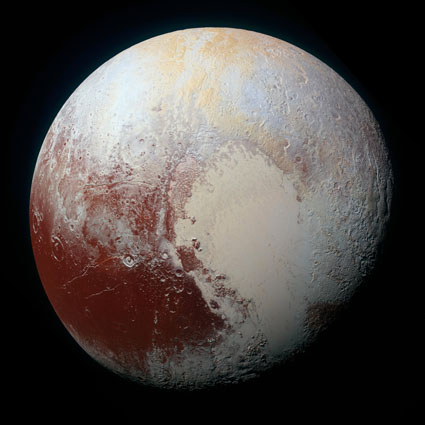
NASA /JHU-APL / SwRI
It felt good to see Pluto again. A 14th-magnitude mote of light holed up in starry Sagittarius, it's easy to ignore. Appearance-wise Pluto isn't much to look at, but I still find it one of most fascinating objects in the sky. And thanks to the New Horizons flyby four years ago, we can finally put a face on its pinpoint visage.
At just 2,370 km wide, or 68% the size of Earth's Moon, Pluto hosts an active, heart-shaped nitrogen-ice glacier that's bigger than Texas and Oklahoma combined, rugged water-ice mountains with peaks that soar to 6.2 km (20,000 feet), red snow, and an atmosphere where organic molecules scatter light to create a blue sky similar Earth's. Its five moons, thought to be born of an ancient collision between the dwarf planet and another Kuiper Belt body, give it a planet-like air. One of them, Charon, is almost half Pluto's size.
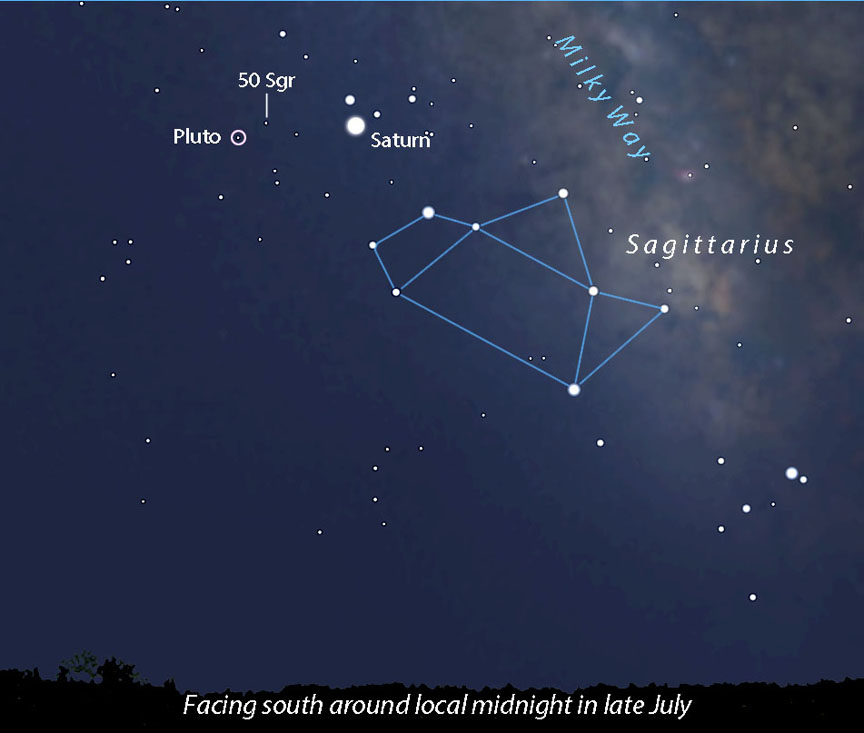
Stellarium
Five billion kilometers from the Sun, Pluto's average surface temperature is –229° C (–380° F), making it one of the coldest things you can look at on a sweltering summer night, the astronomical equivalent of a dunking your eye in a glass of ice water.
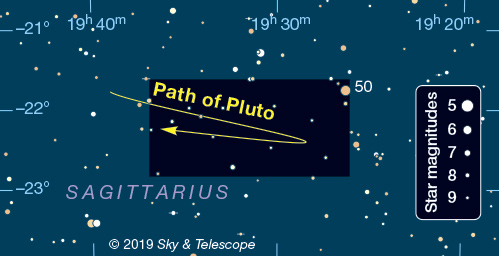
The Sun, Earth, and dwarf planet aligned at opposition on July 12th, but I thought it would be wise to give Pluto some time to climb out of the haze before making a visit. From mid-northern latitudes it culminates around 25° altitude near midnight local time late this month. Seeing is rarely crisp at this elevation, but if you keep at it, you're bound to score a night of good seeing. An 8-inch under dark skies is probably the minimum size scope you'll need to spot Pluto.
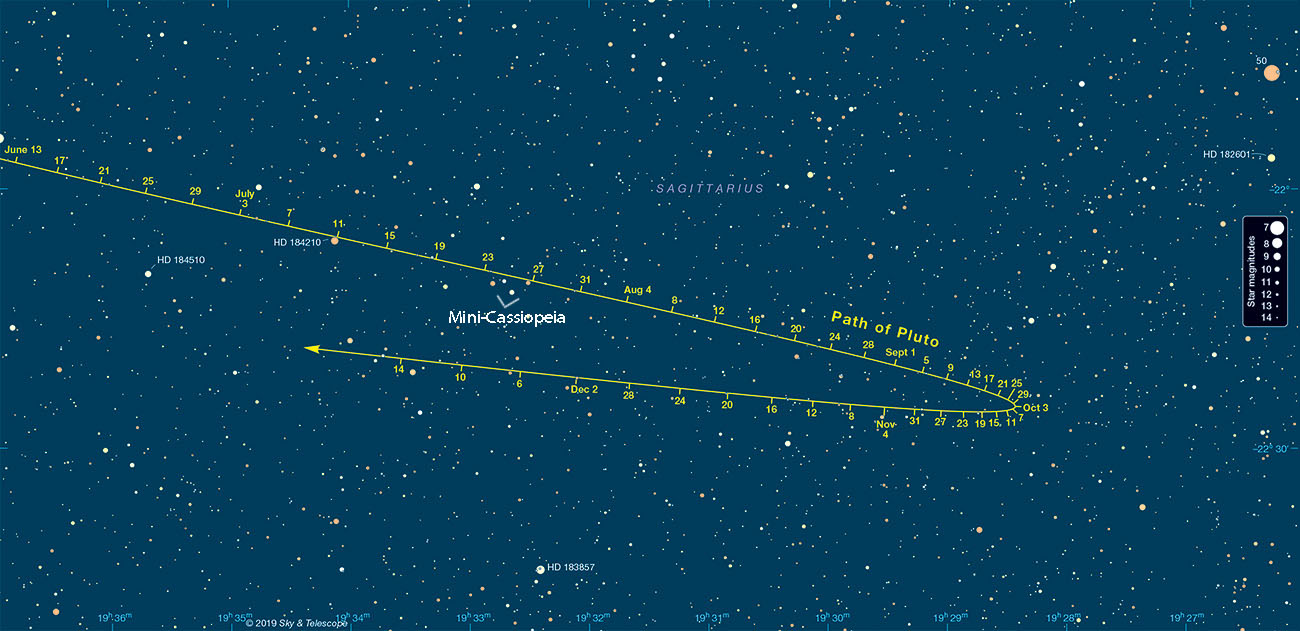
Sky & Telescope
A good chart is essential to thread your way to the faint dwarf planet, currently shining at magnitude 14.2, but at least you have a bright, easy place from which to begin — Saturn. Pluto lies 4° almost due east of the planet, not far from the magnitude-5.5 star 50 Sagittarii. From Saturn you can slide to 50 Sgr and then make your way to Pluto via star-hopping using created-in-the-moment asterisms. I give them silly names to help me remember the way.
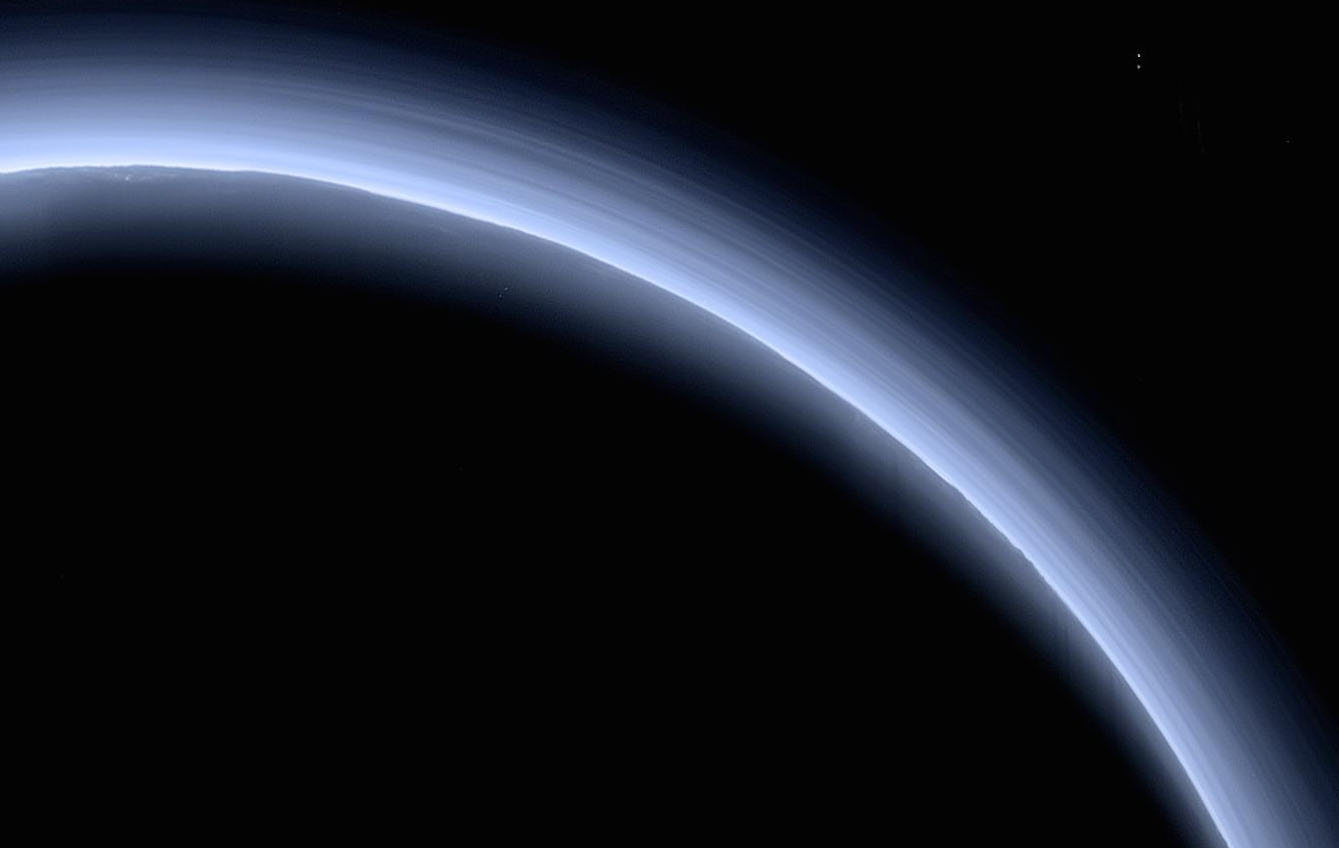
NASA / JHU-APL / SwRI
I observed Pluto most recently on July 22.2 UT in my 15-inch reflector at an altitude of 19° in mushy seeing with a magnification of 245×. With averted vision and patience I had no problem spotting the tiny stellar flicker. As with any faint, moving object, it's a good idea to check the next clear night to confirm your observation. Pluto doesn't move much, but it does move enough, about 1.5 arcminutes a day. At 200×, that's plenty to detect motion from one night to the next. When I dialed in Pluto some 48 hours later on July 24.2 UT, its westward movement was more than obvious.
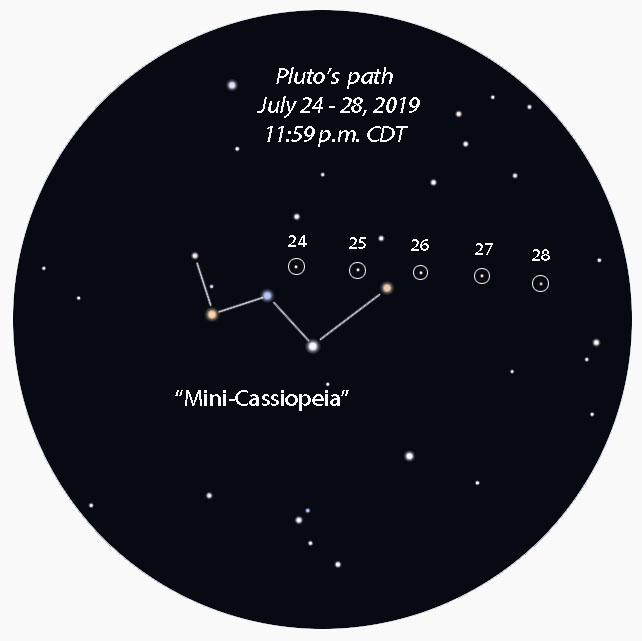
Bob King
That's one of the pleasures of watching Pluto — seeing it move. First off, you know you've clinched the observation, but you also you get to go along for the ride. Inch-worming along each night, it will take Pluto 248 years to return to where you see it tonight. In the coming years the dwarf planet will continue to fade from its peak brightness of 13.7, achieved in the late 1980s when it was last closest to the Earth. Come 2114, when Pluto reaches aphelion, it will have moved 2.4 billion km further from the Sun and faded to magnitude 15.9. Pluto won't return to its current brightness until 2211. See it while you can!
You can either use the chart provided or plot its location using any number of star-plotting programs. Although Stellarium can't produce a path, it will show its nightly position accurately, and you can magnify the scene for easier star-hopping.
Good news for Pluto-watchers now through the end of July! The dwarf planet will pass near a relatively bright asterism of 10.5-magnitude stars shaped like the W of Cassiopeia, making this a prime opportunity to track its movement. Good luck in your quest to find this icy point of light, and let us know if you succeed.
 19
19








Comments
Anthony Barreiro
July 24, 2019 at 7:27 pm
Thanks Bob. Your charming description of Pluto as revealed by New Horizons makes me want to seek it out. And the fact that Pluto is getting farther from the Sun and thus dimmer gives me a sense of urgency. But with a little telescope in a light-polluted city, I'll have to settle for imaginary flights of fancy. I still printed out the chart, in case I cross paths with somebody with a big dob when I'm up in the Sierra next month.
By the way, July 22.2 UTC = 0448 UTC on 22 July, or 11:48 pm CDT on July 21, right?
And by the other way, when we see an outer planet moving retrograde against the more distant stars, we're not actually seeing the planet moving -- we're seeing parallax as Earth moves along in our faster orbit closer to the Sun. The only way to observe Pluto's glacially slow orbit is to compare the planet's current position to where he was one year ago, or to where he'll be on the same date next year. Sorry to be a quibbling wet blanket.
You must be logged in to post a comment.
Bob KingPost Author
July 25, 2019 at 12:14 am
Hi Anthony,
On the time, yes, that is correct. On Pluto's movement, that is strictly true — much of the movement is due to the Earth's motion. I was referring to movement in general night-to-night, but I appreciate you highlighting the difference. I checked and during a typical year at this time, Pluto moves about 2° eastward in its orbit per year.
You must be logged in to post a comment.
Anthony Barreiro
July 25, 2019 at 2:59 pm
2 degrees per year is pretty fast for a 14th magnitude speck! 🙂
You must be logged in to post a comment.
Rod
July 26, 2019 at 9:05 am
Bob, very good report. My problem is similar to Anthony, viewing from a light polluted sky where limiting magnitude on good evenings is about mv +5.5, even with my 10-inch Newtonian, not likely to see Pluto. However, last night I did view Jupiter and Saturn from 2130-2330 EDT and share this note. "I enjoyed some Jupiter and Saturn observing last night using my 90-mm refractor and 10-inch Newtonian. Jupiter retrograding in Ophiuchus is very close to globular cluster NGC 6235 last night and tonight (4 arcminute tonight). I could just barely detect using the 10-inch because of Jupiter’s brightness, no stars resolved just faint, small fuzzy, Jupiter, cloud bands, and 4 Galilean moons visible. Saturn I observed from 35x to 100x views. Many stars in Sagittarius visible all around in the field of view, especially at 35x and 1.8-degree true FOV – quite a sight. At higher powers I could see Cassini division, cloud banding, and shading in north polar area of Saturn along with 4 Saturnian moons. After 10:30 PM, altocumulus clouds moved in and started making it difficult so I went back in near 11:30 PM EDT."
You must be logged in to post a comment.
Joe Stieber
July 26, 2019 at 12:50 pm
Bob -- Thanks for another fine article!
I've been meaning to get out for a look at Pluto this summer since it's been more than a few years since I've done so. I have a relatively new 16-inch Dob and spotting Pluto with it has been on my to-do list, as sighting Pluto was one of the justifications for getting this new scope (as if aperture fever needed an excuse). It was getting tough to see Pluto with my 12.5-inch Dob and my aging eyes.
Anyway, prompted by your article, a clear sky (finally) and a several-hour window of darkness between the end of astronomical twilight and moonrise, I headed out to my southern New Jersey Pines observing site last night (July 25-26, 2019) where temperatures were refreshingly cool and the Milky Way was easily visible -- it bordered on being "billowing" (very good, but not excellent transparency).
Turns out your "mini-Cassiopeia" asterism was a superb guide to finding Pluto, which I initially saw at 12:30 am with an 11 mm eyepiece (166X). At that magnification, it was mostly seen with averted vision, occasionally popping out with a direct view. At 12:40 am, I looked with a 6.7 mm eyepiece (273x) and could see it continuously with direct vision. In both cases, it was just a pinprick of light. As is shown in your close-up chart for 11:59 pm CDT on July 25 (July 26, 12:59 am EDT), Pluto formed a nearly equilateral triangle with two adjoining stars. I hope I can get out on one of the next couple of nights to follow-up on its motion.
Soon after moonrise, I also looked at Neptune with the 16-inch at 273x. It showed a nice blue disc, but I couldn't pick up its magnitude 13.5 satellite, Triton, 10 arc seconds away. By time I was looking at 1:15 am, the sky was brightening from moonlight.
BTW, Jupiter (plus the Great Red Spot) and Saturn were wonderful in the 16-inch.
You must be logged in to post a comment.
Joe Stieber
July 26, 2019 at 2:14 pm
P.S. -- Pluto was about 5.6° east of Saturn last night (July 25-26, 2019) rather than the 4° mentioned in the article.
You must be logged in to post a comment.
Bob KingPost Author
July 26, 2019 at 2:57 pm
Hi Joe,
You are absolutely correct! When I measured their separations with Stellarium earlier I mis-read my reading. Thank you for pointing out the error -- it is now corrected.
You must be logged in to post a comment.
Bob KingPost Author
July 26, 2019 at 3:00 pm
Hi again Joe,
Great observation — thanks for sharing it with our readers. And I'm glad the mini-Cassiopeia helped :). That reminds me I've got to get the scope out late and welcome Neptune and Triton back.
You must be logged in to post a comment.
plutogirl
August 1, 2019 at 1:56 pm
Wow, you saw Pluto from a site in NJ? Where exactly is this, and is it open to the public?
You must be logged in to post a comment.
Joe Stieber
August 2, 2019 at 2:51 pm
I was at Carranza Field in Wharton State Forest, which is nominally halfway between Philadelphia, PA, and Atlantic City, NJ (each about 30 miles away in the northwest and southeast respectively). On a clear, moonless night, I can regularly see stars to magnitude 5+, and when transparency is really good, perhaps magnitude 6 (my aging eyes don't see 6 as well as they used to). Anyway, the State Forests are, I believe, technically closed from dusk to dawn, but I don't pay much attention to that. I haven't seen a park ranger out there in a long time, and I infrequently see anyone at all. Occasionally, there are some folks at the campground I pass on the way in. While it may not be a necessity, it's prudent to have a 4WD vehicle since the pot-holed, packed-sand road turns to sugar sand after the campground (loose white sand, just like the Atlantic beaches of NJ).
You must be logged in to post a comment.
Larry McNish
July 30, 2019 at 1:20 am
I took an image of Pluto next to the "mini-Cassiopeia" asterism very early on July 28 for you Bob.
It's at: https://grumpyoldastronomer.com/images/Pluto_2019-07-28_at_RAO_MWN.jpg
You must be logged in to post a comment.
Bob KingPost Author
July 30, 2019 at 11:27 am
Nice photo, Larry! Great capture of Pluto especially considering the altitude. Thanks!
You must be logged in to post a comment.
Joe Stieber
July 30, 2019 at 6:58 pm
Indeed, a good shot Larry!
I can clearly see where Pluto is absent from the spot where I saw it visually on July 26, and I made a negative to print out for a finder chart at the eyepiece, hopefully tonight (if the weather cooperates).
You must be logged in to post a comment.
Joe Stieber
July 31, 2019 at 1:47 pm
Actually, I should have said reference chart rather than a finder since Pluto would have moved again since July 28. I did make it out last night, and at 12:40 am EDT on July 31, I spotted Pluto again with the 16-inch Dob using mostly averted vision at 166x, and then could see it almost continuously at 208x. Pluto was about 7 arc minutes west of the position where I saw it five days earlier, and of course, when I checked the spot where I saw it on July 26, it was absent.
You must be logged in to post a comment.
Martian-Bachelor
October 24, 2019 at 7:31 pm
I got it the very next night from Larry, using only an 8-y.o. DSLR (bought used on eBay) and an F=200mm telephoto lens, ISO 400, and a single 30 second exposure (so it's noisy)...
It's at https://VISNS.NeoCities.org/VISNS_pics/CW_D1703_lb.jpg
We had a stretch of great weather ~3 weeks later that ran for half a dozen consecutive nights or more. I'd put together a little movie or time lapse animation of Pluto's motion through the field if I could find the time to work on it.
You must be logged in to post a comment.
Larry McNish
July 31, 2019 at 2:19 am
Other Sky&Telescope Pluto fans might be interested in reading my article (written in 2016) about the discovery images as well as Pluto Crossing the Ecliptic in 2018 for only the second time since it's discovery.
https://calgary.rasc.ca/pluto2018.htm
You must be logged in to post a comment.
Raoul
August 29, 2019 at 10:43 am
Dear Bob, Thank you for the inspiration.
From my location in South Africa, with a Bortle sky of 6-7, I had no hope to see Pluto but using a SW ED120 and a Nikon D5200, 13 second exposure at 800 ASA and about 100 subs later, I took two pictures 24 hours apart, first on 27 August 2019 and second on 28 August 2019 to prove I am looking at Pluto
moving.
Pity I cannot post the pictures here.
You must be logged in to post a comment.
Monica Young
August 29, 2019 at 11:14 am
Ah but you can, in our online gallery! --> https://skyandtelescope.org/astronomy-pictures/share-your-astronomy-pictures/
You must be logged in to post a comment.
Raoul
August 29, 2019 at 12:11 pm
Thank you Monica !
I did place it in the online gallery.
You must be logged in to post a comment.
You must be logged in to post a comment.